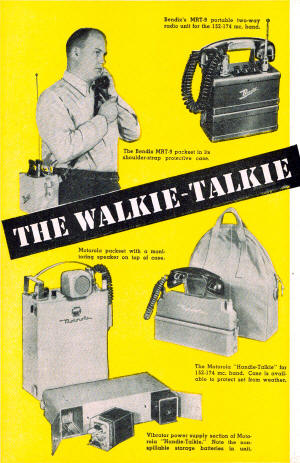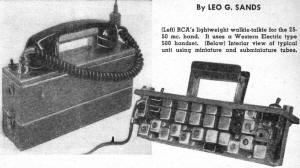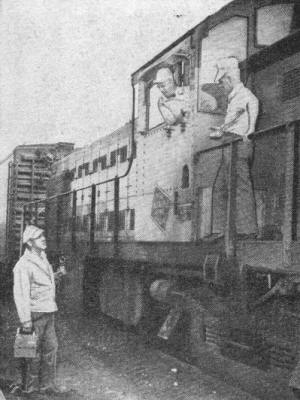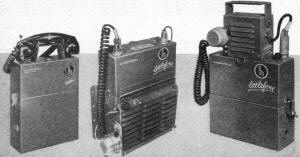|
Just as early cellphones
(Motorola's Bag Phone,
e.g.) required large carrying cases to contain both the large electronics and the
large battery required to operate the phone, some of the first commercially available
portable personal radio sets came with shoulder straps. Those that didn't have straps
had wheels and a handle. The "walkie-talkie" (originally called "handi-talkies")
designs were first seen during
World War II
and then in Korea.
In fact, this 1955 article from Popular Electronics was printed shortly after the
end of the conflict in 1953. Don't confuse the radio-based portable
field telephones
with the ones that had a pair of wires (sometimes thousands of feet of it) that
did not need complicated circuitry for over-the-air transmitting and receiving.
See also
The Walkie-Talkie - March 1955 Popular Electronics,
A
Self-Contained Handie-Talkie - June 1944 QST, and
The New Handy-Talkie - December 1942 Radio-Craft,
Walkie-Talkies: Something for Everyone - April 1974 Popular
Electronics,
A Self-Contained
Handie-Talkie - June 1944 QST,
Inside the Handie-Talkie
- July 1946 Radio-Craft.
The Walkie-Talkie

Bendix's MRT-9 portable two-way radio unit for the 152-174 mc. band.
The Bendix MRT-9 packset in its shoulder-strap protective case.
Motorola packset with a monitoring speaker on top of case.
The Motorola "Handie-Talkie" for 152-174 mc. band. Case is available to protect
set from weather.
Vibrator power supply section of Motorola "Handie-Talkie." Note the non-spillable
storage batteries in unit.
By Leo G. Sands
Two-way radio has captured the imagination of the public - here is the story
on available units and operating rules.
The portable two-way radio has been brought vividly to the attention of the public
by "Dick Tracy." His is the two-way radio which would sell like the proverbial hot
cakes if it really existed. Many are trying to develop a "Dick Tracy" radio and
no doubt someone will succeed.
Today, crime fighters must content themselves with somewhat heavier and bulkier
portable two-way radio sets. Several excellent portable units are on the market
and they do a commendable job, even if they fall short of the performance of "Dick
Tracy's" wrist radio.
Depending, upon their size and form factor, they have been called, among other
things, a walkie-talkie, "Handie-Talkie" (a trade name), pack set, "Port-A-Fone"
(also a trade name), and a breakie-backie.
If you buy a pair of walkie-talkies, there is no assurance you can use them.
All radio transmitters, even flea-powered, hand-carried portables, must be licensed
by the Federal Communications Commission (FCC). Different kinds of walkie-talkies
are designed for licensed operation in different categories of radio services as
defined by the FCC. Equipment for use in the industrial, land transportation, and
public safety radio services must generally meet more rigid technical standards
than equipment to be used in the Citizens or amateur radio services.
Unless you operate a business which is eligible for licensing in the land transportation
or industrial radio services or unless you are an amateur radio operator, you as
an individual can only operate walkie-talkies in the Citizens radio band. The Citizens
band is open to all citizens whether for private personal use or in connection with
a legal commercial enterprise.
For use only in the Citizens radio service on 465 megacycles are such low-priced,
hand-carried two-way radio units as the Stewart-Warner "Port-A-Fone." Here, the
range is limited from a few hundred feet to a mile or more, depending upon local
conditions. This type of unit uses a super-regenerative receiver which is converted
into a self-excited AM transmitter.
The more widely used and more expensive portable two-way radio units are designed
for operation in either the 25 to 50 megacycle or 152 to 174 megacycle v.h.f. (very-high-frequency)
bands which are reserved exclusively for eligible commercial enterprises and government
agencies.
To meet FCC requirements, these commercial pack sets employ crystal-controlled
transmitters operable on one or two specifically assigned fixed frequencies within
the band for which the equipment was designed. Fixed tuned superheterodyne receivers,
which are also crystal controlled, are used. Transmitter and receiver are packaged
in the same enclosure along with either wet or dry batteries.

(Left) RCA's lightweight walkie-talkie for the 25-50 mc. band. It uses a Western
Electric type 500 handset. (Right) Interior view of typical unit using miniature
and subminiature tubes.
When wet batteries are used, they rare of the non-spillable type and are used
to supply filament power and to drive a vibrator power supply for plate power for
the tubes in the transmitter and receiver. Generally, when dry batteries are used,
plate power is derived directly from "B" batteries instead of a vibrator power supply.
Both subminiature and miniature type tubes are used in commercially available
walkie-talkies. The transistorized walkie-talkie has not yet made its debut and
is not expected to do so, at competitive prices at least, for quite some time.
The antenna used with nearly all of the commercially available walkie-talkies
is either a vertical flexible quarter-wave whip or a telescoping antenna similar
to those used in automobiles. An external antenna may be used in fixed or mobile
applications by removing the antenna and plugging in a coaxial cable leading to
the antenna.
The range obtainable with walkie-talkies is sometimes amazing, especially when
operating in the 25 to 50 megacycle band. A range of 8 or 10 miles between a walkie-talkie
and a higher powered base station is often reported. However, much depends upon
terrain conditions.

Pack sets are used by many railroads to extend communications to the man on foot.
The unit shown here is manufactured by Hallicrafters.
Operating in the 152 to 174 megacycle band, the range is generally considerably
less. However, communication between a walkie-talkie on this band and a higher powered
base station up to 8 or 10 miles has been achieved but not as regularly as when
operating in the 25 to 50 megacycle band.
The range between a pair of walkie-talkies is generally quite limited because
of the power output of the transmitters and because of the low effective antenna
elevation. Of course, the range can be several miles if one walkie-talkie is operated
on a hill top and the other one is within line-of-sight or at a point where signals
are easily reflected.
In railroad yards, for example, many have been disappointed to find the range
attainable between a pair of pack sets is so short as to be unsatisfactory. This
is particularly true when one or both walkie-talkies are carried by personnel standing
or walking between freight cars. This would also apply in congested areas as in
city streets lined by tall buildings or many trees.
The cure in such cases is to employ a relay station if permitted by FCC regulations
in the service in which the equipment is to be operated. When using a relay station,
two different radio frequencies are required, one for transmitting and one for receiving.
Motorola and General Railway Signal Company have developed novel portable transmitters
for one-way radio communication. They are not much larger than a flashlight and
are primarily used in railroad yards where personnel on foot talk out over a portable
transmitter and receive calls and replies over a public address system. A typical
walkie-talkie like the MRT-8 manufactured by Bendix weighs only eight pounds and
is available for hand carrying or for mounting on personnel with suitable straps.
Hallicrafters manufactures portable two-way radio units which can be adapted for
installation in motor vehicles. Power is derived from the vehicle's electrical system.

Three versions of the Hallicrafters "Littlefone." (Left) The standard model with
handset. (Center) Unit adapted for under-the-dash mounting in a car. It is powered
by car battery. (Right) "Littlefone" with a 4" speaker mounted on case.
Surplus walkie-talkies offered at bargain prices are seldom licensable without
extensive modification. Very few, if any, military surplus portable radio telephones
can be readily modified for use in the 25 to 50 mc., 152 to 174 mc., or the 450
to 470 mc. bands. Some, however, can be modified for operation in one or more of
the amateur bands. However, to be eligible to operate walkie-talkies in the amateur
bands, it is necessary to possess an amateur operator's license which requires taking
a code test and passing a written examination on radio theory and FCC regulations.
In the land transportation, industrial, and public safety radio services, persons
using mobile and portable stations do not need operator's licenses although the
operator of an associated base station must possess a restricted radio telephone
operator's permit. Although a station license is required for Citizens band walkie-talkies,
an operator's license is not needed.
It is possible to build your own walkie-talkies for use in the Citizens band
or in one of the commercial radio services. However, to build such equipment so
that it will comply with FCC regulations requires considerable skill, a vast amount
of precision test equipment, a good deal of time, and ample funds. It is generally
cheaper to buy factory-made equipment. Commercially available walkie-talkies cost
from $200 to $500 each.
Posted November 30, 2020
(updated from original post on 2/17/2014)
|













